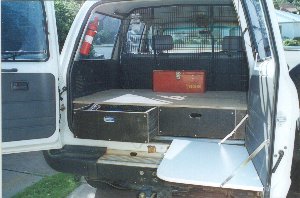
Tools and Spares

 Some 4WD's are so overloaded that when the suspension
breaks, the driver congratulates himself for having a spare spring, along with a spare
axle, shock absorber, clutch plate etc etc etc. The overloading of the vehicle is in many
cases the reason why various components break. By the some token, venturing into the
outback with just the vehicle’s original toolkit is inviting disaster.
Some 4WD's are so overloaded that when the suspension
breaks, the driver congratulates himself for having a spare spring, along with a spare
axle, shock absorber, clutch plate etc etc etc. The overloading of the vehicle is in many
cases the reason why various components break. By the some token, venturing into the
outback with just the vehicle’s original toolkit is inviting disaster.
What is needed is a common sense approach. If your vehicle is getting on in years, then chances are more components are near the end of their working life. This will necessitate carrying more spares, however it is not a license to overload the vehicle.
For example, all vehicles should always carry some method of repairing a blown radiator hose. It doesn't mean you have to carry every hose the vehicle has, but perhaps a multi-fit hose and a roll of rubber-weld tape would be sufficient,
A spare fan belt is critical to keep the engine running, but a spare air-conditioner belt will not stop you. However, the amount of room a spare a/c belt takes up is minimal and some may say an air conditioner can be considered vital in the hot outback!
Another common sense area is the amount of spare oil you carry. An 80 series diesel Landcruiser needs nearly 10 litres of engine oil, along with diff, gearbox and transfer case oils. Each of these oils is a different grade, even the front and rear diff oil is different, as the rear is a limited slip diff. To carry enough oil would mean around 20 litres in five different containers. In a break down situation the old saying 'oils ain't oils' isn't true. Engine oil can be used in all of these areas to allow you to get to civilisation. It doesn't mean you can continue your trip indefinitely without obtaining the right oil as soon as practical. An exception to this is an automatic transmission. It needs the correct grade of oil to function.
Carrying sufficient tools is another contentious issue. You don’t need to carry enough tools or spares to perform an engine rebuild in the middle of the Simpson Desert, however some specialty items you should carry include the right socket to fit your diff drain plug, along with a small sump pump to fill it.
Carrying a torque wrench and a complete set of ring, combination and open ended spanners in metric and imperial sizes is a case of being over prepared. A set of spanners in the correct size for your vehicle, along with a few sizes of crescents should be all that's required in the way of spanners. One item you should ALWAYS carry is a Repair Manual for your vehicle. Even if you cannot fix your vehicle, chances are a passing good samaritan 4WDriver can, if he has the manual.
Repairing a vehicle in the bush is about improvisation. If a spring does break, take a spare tyre off its rim and place the tyre between the axle and body. It may not be fancy, but it will get you mobile. Carrying a can of 'Bars Leak' or a roll of solder will allow you to fix most radiator holes or burst seams, using a screwdriver or similar heated in a fire to act as a soldering iron. A roll of wire is worth more than the largest selection of nuts and bolts in most cases.
What is to be considered are components that will stop a vehicle if they fail. For example, a blocked fuel filter has probably caused more problems in the outback, due to drum fuel, dust and vibration caused by corrugated roads.
The most important thing is to let people know your itinerary so you know help is on its way once you become overdue. When in the outback, ALWAYS stay with your vehicle in a breakdown situation and wait for help. This may take days and is why you should always carry extra food and water.
In most coastal areas it would be rare to go even a few hours without seeing another vehicle, so the consequences are not as dramatic. However, this does not mean you should venture out unprepared and rely on a passing 4WDriver for help.
The most important thing is to be adequately prepared for the remoteness of your destination. (c) 4WD Encounter 1998
These pages were last
updated on 3rd November 1998.
Hits since 28th October 1998: